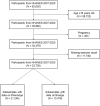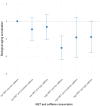Joint association between physical exercise, caffeine intake, and biological ageing: A cross-sectional analysis of population-based study
- PMID: 40334227
- PMCID: PMC12058179
- DOI: 10.1371/journal.pone.0323264
Joint association between physical exercise, caffeine intake, and biological ageing: A cross-sectional analysis of population-based study
Abstract
Background: Ageing is a significant risk factor for age-related diseases, accounting for 51% of global total disease burden. As thus, promoting healthy ageing is crucial. Although several potential anti-ageing drugs show promise, none have been approved for anti-ageing purpose. The World Health Organization (WHO) recommends physical exercise exceeding 600 metabolic equivalent of task (MET) minutes per week for adults. However, whether physical exercise positively impacts healthy biological ageing remains unclear.
Objective: This study aimed to investigate the joint correlation between MET level, caffeine consumption, and biological ageing.
Methods: We analyzed data from seven survey cycles (2007-2020) of the National Health and Nutrition Examination Survey (NHANES), involving 23,739 participants. Physical activity levels were measured in MET minutes per week, and biological ageing was assessed using both the PhenoAge and ENABL Age algorithms. Generalized linear regression for survey data was employed to test correlations, adjusting for confounding factors. A cubic spline model was used to detect non-linear relationships. Pre-specified subgroup analyses explored effect modifications, while predefined sensitivity analyses confirmed the robustness of the results.
Results: Each 100-MET increase in weekly physical exercise was associated with a 0.2-year delay in biological ageing (p < 0.001 for both PhenoAge and ENABL Age). Individuals with less than 600 MET minutes of weekly exercise had a higher risk of accelerated ageing compared to those exceeding 600 MET minutes (mean difference [MD]: 2.2 PhenoAge years, 95% CI [1.5-2.8], p < 0.001; MD: 2.1 ENABL Age years, 95% CI [1.1-3.1], p < 0.001). A L-shaped association was observed, with diminishing benefits of delayed ageing beyond 292 MET minutes for PhenoAge and 259 MET minutes for ENABL Age. Daily caffeine intake did not modify the correlation between MET levels and biological ageing (p for interaction > 0.05). Stronger effects were observed in non-Hispanic Black individuals, those with obesity, and low-income populations, but no benefit was found in cancer patients.
Conclusions: Our findings highlight a positive correlation between higher levels of weekly physical exercise and delayed biological ageing. However, the benefits plateau beyond specific MET thresholds. Caffeine intake does not influence this relationship. These results underscore the importance of promoting physical exercise at appropriate MET levels as a strategy for healthy ageing management in the general population.
Copyright: © 2025 Chen et al. This is an open access article distributed under the terms of the Creative Commons Attribution License, which permits unrestricted use, distribution, and reproduction in any medium, provided the original author and source are credited.
Conflict of interest statement
All authors declare that they have no competing interests.
Figures




Similar articles
-
Bidirectional associations of zinc supplement intake with biological ageing interacted by metabolic equivalent of task: A large-scale population-based Biobank study.Clin Nutr. 2025 Jul;50:1-9. doi: 10.1016/j.clnu.2025.04.029. Epub 2025 May 2. Clin Nutr. 2025. PMID: 40359759
-
Associations between biological ageing and the risk of, genetic susceptibility to, and life expectancy associated with rheumatoid arthritis: a secondary analysis of two observational studies.Lancet Healthy Longev. 2024 Jan;5(1):e45-e55. doi: 10.1016/S2666-7568(23)00220-9. Epub 2023 Dec 8. Lancet Healthy Longev. 2024. PMID: 38081205
-
The association of visceral and subcutaneous fat areas with phenotypic age in non-elderly adults, mediated by HOMA-IR and HDL-C.Lipids Health Dis. 2025 Jan 24;24(1):22. doi: 10.1186/s12944-025-02446-4. Lipids Health Dis. 2025. PMID: 39856735 Free PMC article.
-
Interventions for promoting physical activity in people with neuromuscular disease.Cochrane Database Syst Rev. 2021 May 24;5(5):CD013544. doi: 10.1002/14651858.CD013544.pub2. Cochrane Database Syst Rev. 2021. PMID: 34027632 Free PMC article.
-
The relationships and interactions between age, exercise and physiological function.J Physiol. 2019 Mar;597(5):1299-1309. doi: 10.1113/JP277071. Epub 2018 Dec 17. J Physiol. 2019. PMID: 30422311 Free PMC article. Review.
Cited by
-
Caffeine Modulates Cell Death and Telomerase Activity in Triple-negative Breast Cancer Cells.Int J Mol Cell Med. 2025 Jul 11;14(2):606-619. doi: 10.22088/IJMCM.BUMS.14.2.606. eCollection 2025. Int J Mol Cell Med. 2025. PMID: 40765763 Free PMC article.
References
MeSH terms
Substances
LinkOut - more resources
Full Text Sources
Medical
Research Materials
Miscellaneous

